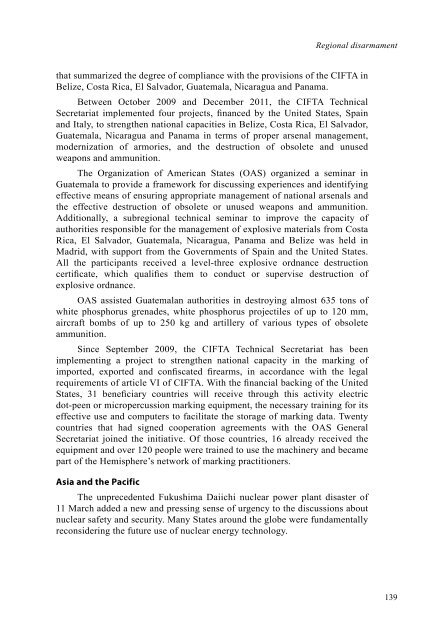DYB2011-Part-II-web
DYB2011-Part-II-web
DYB2011-Part-II-web
You also want an ePaper? Increase the reach of your titles
YUMPU automatically turns print PDFs into web optimized ePapers that Google loves.
Regional disarmament<br />
that summarized the degree of compliance with the provisions of the CIFTA in<br />
Belize, Costa Rica, El Salvador, Guatemala, Nicaragua and Panama.<br />
Between October 2009 and December 2011, the CIFTA Technical<br />
Secretariat implemented four projects, financed by the United States, Spain<br />
and Italy, to strengthen national capacities in Belize, Costa Rica, El Salvador,<br />
Guatemala, Nicaragua and Panama in terms of proper arsenal management,<br />
modernization of armories, and the destruction of obsolete and unused<br />
weapons and ammunition.<br />
The Organization of American States (OAS) organized a seminar in<br />
Guatemala to provide a framework for discussing experiences and identifying<br />
effective means of ensuring appropriate management of national arsenals and<br />
the effective destruction of obsolete or unused weapons and ammunition.<br />
Additionally, a subregional technical seminar to improve the capacity of<br />
authorities responsible for the management of explosive materials from Costa<br />
Rica, El Salvador, Guatemala, Nicaragua, Panama and Belize was held in<br />
Madrid, with support from the Governments of Spain and the United States.<br />
All the participants received a level-three explosive ordnance destruction<br />
certificate, which qualifies them to conduct or supervise destruction of<br />
explosive ordnance.<br />
OAS assisted Guatemalan authorities in destroying almost 635 tons of<br />
white phosphorus grenades, white phosphorus projectiles of up to 120 mm,<br />
aircraft bombs of up to 250 kg and artillery of various types of obsolete<br />
ammunition.<br />
Since September 2009, the CIFTA Technical Secretariat has been<br />
implementing a project to strengthen national capacity in the marking of<br />
imported, exported and confiscated firearms, in accordance with the legal<br />
requirements of article VI of CIFTA. With the financial backing of the United<br />
States, 31 beneficiary countries will receive through this activity electric<br />
dot-peen or micropercussion marking equipment, the necessary training for its<br />
effective use and computers to facilitate the storage of marking data. Twenty<br />
countries that had signed cooperation agreements with the OAS General<br />
Secretariat joined the initiative. Of those countries, 16 already received the<br />
equipment and over 120 people were trained to use the machinery and became<br />
part of the Hemisphere’s network of marking practitioners.<br />
Asia and the Pacific<br />
The unprecedented Fukushima Daiichi nuclear power plant disaster of<br />
11 March added a new and pressing sense of urgency to the discussions about<br />
nuclear safety and security. Many States around the globe were fundamentally<br />
reconsidering the future use of nuclear energy technology.<br />
139


